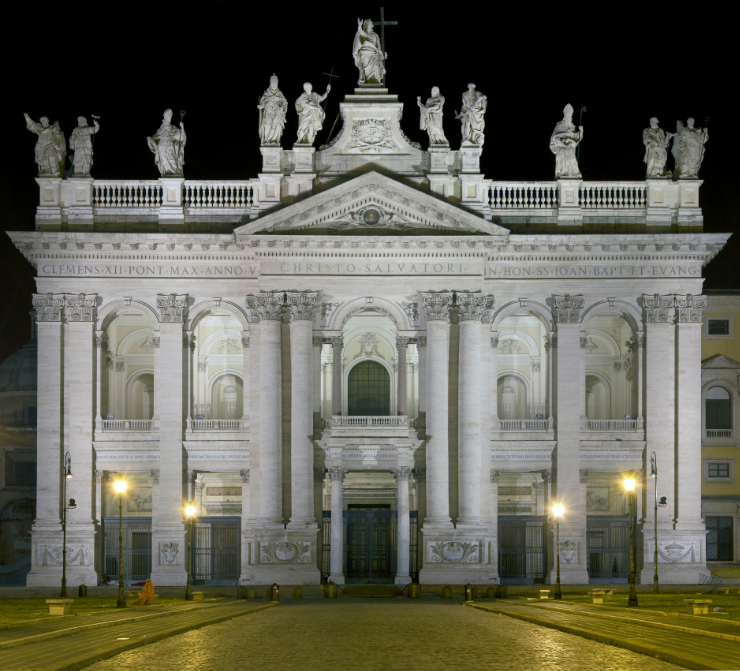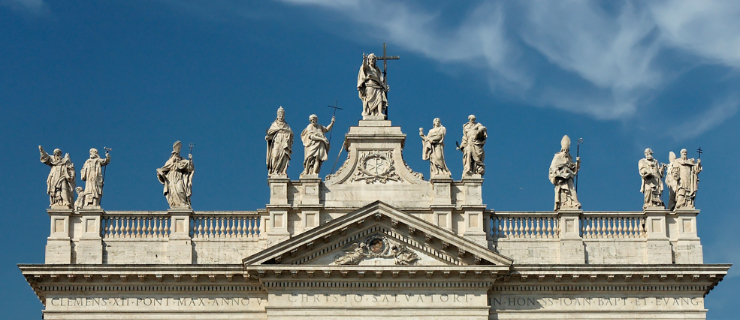Archbasilica of St. John Lateran: Testimony to a Faith that Endures
by Joannie Watson | June 3, 2016 12:04 am

Papal Archbasilica of Saint John in Lateran
Since I made reference to it in last week’s post, and I have already dedicated a whole post to St. Mary Major down the street from it, I think it’s only fair to dedicate a post to the basilica of St. John Lateran.
The Church of St. John Lateran is the mother and head of all the churches of the city of Rome and the world. This title might seem a little odd to us, since we tend to think of St. Peter’s Basilica as being the most important church for Catholics. As Bishop of Rome, however, the Pope has a Cathedral, and that Cathedral is actually St. John Lateran. The Popes lived at the Lateran Palace, connected to the basilica, for over a millennium, and only moved to the Vatican “recently” in the fourteenth century. (To some, the fourteenth century is ancient history, but not for the Church!) This means the Lateran was home to the Popes longer than the Vatican has been. When you think of various events in Church history—Pope Leo the Great going forth to meet Attila the Hun, Gregory the Great sending missionaries to convert the Anglo-Saxons, Francis of Assisi seeking papal approval for his order—all of that happened here, not across town in the Vatican.
So just who was St. John Lateran, anyway? If you get that question in a trivia game, don’t fall for it! That’s a trick question. The Basilica gets its name from the family who used to own the land on which the church and palace were built. It is believed that after landowner Platutius Lateranus was executed for his part in a plot to assassinate the emperor Nero, his property passed into imperial hands, and eventually was included in the dowry of the wife of Constantine. Constantine subsequently built the first great Christian church on this land, making St. John Lateran the oldest church in the West.
The basilica was originally known as the Basilica of the Savior. In the tenth century, it was dedicated to St. John the Baptist, and in the twelfth century was also dedicated to St. John the Evangelist.
When you stand in front of the church and look up at the statues high above you, you’ll see Christ the Savior flanked on either side by John the Baptist and John the Evangelist.
 The church as you see it today is very different than what Christians saw for the first 1500 years of the church. Earthquakes, the various sacks of Rome, multiple fires, and general disuse meant the church had to be rebuilt several times. When the Popes returned to Rome from Avignon, the Lateran Palace and basilica were in terrible disrepair, which is one of the reasons they took up residence in the Vatican instead. In 1650, architect Francesco Borromini drastically altered the interior of the church, encasing the ancient columns with the huge pilasters you see today. The facade was also altered, and by 1735, any indication that the basilica was ancient or even medieval was gone.
The church as you see it today is very different than what Christians saw for the first 1500 years of the church. Earthquakes, the various sacks of Rome, multiple fires, and general disuse meant the church had to be rebuilt several times. When the Popes returned to Rome from Avignon, the Lateran Palace and basilica were in terrible disrepair, which is one of the reasons they took up residence in the Vatican instead. In 1650, architect Francesco Borromini drastically altered the interior of the church, encasing the ancient columns with the huge pilasters you see today. The facade was also altered, and by 1735, any indication that the basilica was ancient or even medieval was gone.
Perhaps the most striking feature of St. John Lateran are the enormous statues that line the nave, each one depicting one of the twelve apostles, and most holding their instruments of martyrdom. Walk slowly through the basilica, looking up at these men. These are the first bishops, the first leaders of the Church. As we know from the Gospels, they all had their faults, but they also had the tremendous courage to suffer for the God who had chosen them personally for the task. The massive statues remind us that all of this—from this glorious basilica to our own parish church—started with twelve humble men open to the Holy Spirit and willing to follow Christ to the end.
One of the greatest treasures in the basilica is one that goes unnoticed by most tourists. High on the wall above the tabernacle, on the left hand side of the sanctuary, is a simple piece of wood behind glass. In front of it is a golden bas-relief of Christ and his apostles. This piece of wood is believed to be from the table of the Last Supper. The twelve men you just looked up at were able to do what they did because they were nourished by the Body and Blood of their Lord in the Eucharist. They spread the Gospel not just by preaching but by celebrating the Mass. And we are united to them today at that same altar of sacrifice at every Mass.
There are many other treasures of Catholic history in the basilica, including relics of the skulls of Peter and Paul (above the main altar), tombs of Popes, beautiful mosaics, and a large baptistry, also built by Constantine, just outside the rear of the church. The Holy Stairs that Christ walked up to meet Pilate, brought back to Rome by St. Helena, the mother of Constantine, were once part of the Lateran Palace but now can be found just across a busy Roman street. But my favorite piece of trivia is found on the way to the baptistry, just behind the basilica. There you will find a large Egyptian obelisk. Obelisks are not a rare sight in Rome—in fact, there are more obelisks in Rome than in any other city in the world. Some are ancient Egyptian, some Roman, and some modern. The obelisk that stands behind John Lateran, however, is the largest standing Egyptian obelisk in the world. It was brought to Rome in 357 AD and first stood in the Circus Maximus. Like many structures of ancient Rome, it was lost and buried for awhile, but when it was rediscovered in the 16th century, it was restored and moved here. Why do I love this obelisk? It dates back to the reign of Thutmose IV in Egypt in the fourteenth century BC. That means it is possible that Moses looked upon this same obelisk.
There’s a reason Rome is called the Eternal City. She never fails to remind me of the endurance of the Truth. Through persecutions by Pharaohs and Roman emperors, despite the martyrdom of our first bishops, amidst plagues and fires and corrupt Popes, the Church endures. Whatever might happen next… Christ wins.
Source URL: https://integratedcatholiclife.org/2016/06/watson-archbasilica-st-john-lateran-testimony-faith-endures/